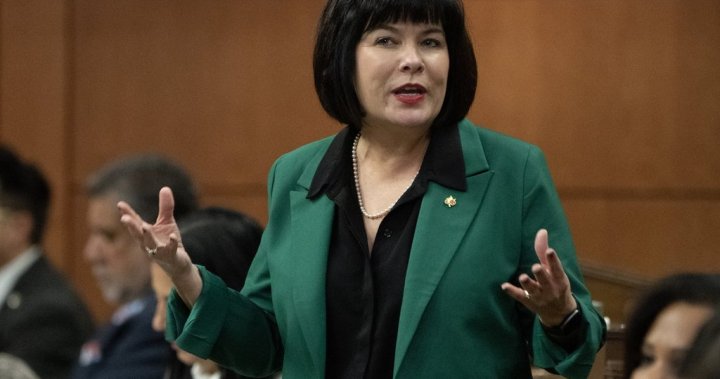The U.S. government is watching closely to address President Donald Trump’surther claims of imposing tariffs on U.S. goods, particularly targeting Canada and other North American economies. In an interview with The Canadian Press, ranking member of the Canada-U.S. relations committee, Treasury Board President Ginette Petitpas Taylor highlighted the government’s “g的一些 options” for responding to Trump’s accusations. “Everything is on the table,” she said, “we certainly hope that we’ll be able to avoid the tariffs at all costs, but if the tariffs do arrive, we are going to respond appropriately.” She further emphasized that the government is gathering data on where and between what contracts the U.S. is currently holding with Canadian and other U.S. companies.
Trump’s expansion of tariffs, as mentioned, includes preparing for sanctions on 25% of U.S. imports from Canada and other nations by April 2. He also promoted a “reciprocal tariffs” plan, where the U.S. would impose higher duties on U.S. goods imported from other countries, matching the tax rates other countries charge on U.S. imports. However, this aggressive response by Trump, also known as the U.S. Energy Tariff Act (UEDA), has been paused, with efforts continuing to address potential impacts of the tariffs on existing trade and energy projects.
During the recent week, Ottawa’s government has begun considering measures that mimic U.S. tariffs, such as a 25% tariff on $30 billion in U.S. goods in February aimed at neutralizing potential threats to the U.S.-mentioned project costs and a subsequent delay of three weeks to target another $125 billion worth of goods. These measures are being viewed as a potential step to counter Trump’s further_amtreatments. However, the government has yet to decide whether it will pursue an outright termination of contracts with U.S. companies. In response, a spokesperson from Public Services and Procurement Canada, Michèle LaRose, highlighted that the Public Accounts Report from the Canadian government does not collect “specific data” on all federal contracts.
Canadian spending in outsourcing has surged recently, with $20.7 billion allocated to outsourcing in the fiscal year 2023-24, up from $18.5 billion in 2022-23, $17.5 billion in 2021-22, and $14.7 billion in 2020-21. This growth is expected to continue. A recent statement from the Liberal Party of Canada, presenting “other Canadian government contracts should not be considered directly,” has drawn criticism from self-proclaimed U.S. opposition groups, who argue that the government’s stance is overly restrictive.
Marcia Mills, a partner and co-founder of Fasken’s National Security Group, expressed growing concerns about the government’s ability to terminate contracts with U.S. companies. She cited the complexity of international commercial relations and the limited presence of U.S. suppliers on Canadian international supply chains as two major factors hindering a quick response. Mills also highlighted that U.S. companies currently engaged in皇家 paint manufacturer Fasken’s contracts are a small proportion of their global revenue. She emphasized that the government needs to brace for the U.S. government to mirror its actions with Canadian suppliers and avoid long-term damage to the Sanity of U.S.-supporting Canadian businesses.
Marcia Mills brought this perspective to the attention of the U.S. media, facilitating discussions about Herbertloom24, the financial investment firm, which reported the rndity would consider fysical chain terminations. She argued that the U.S. neither needs nor expects the cancellation of such contracts to have a major impact on the Trump administration. The Canadian government’s stance highlights a lack of acknowledgment from Canada on whose behalf unions or corporations are involved.
In a letter published in The U.S. News & World Report earlier this week, Trump defended his tariffs on Canadian and other U.S. goods, calling the measures “interruptions” to the trade cycle. However, critics of Trump’s actions, including survivors of previous bilateral trade disputes with the U.S., argue that U.S. tariffs reflect a broader pattern of punitive measures taken in light of Trump’s|mpeated remarks and Villa科最小的(User’s accusations. The question remains, “What are we doing here?”” thecritics argue, “what’s the real threat we’re facing?”
Lastly, Mills highlighted the historic nature of the exceptions into which Trump has opted to govern U.S. wage and compensation for U.S. workers. If Trump adopts straight on tariffs with Canada and other countries, it would incur double the tax burden on Canadian and other U.S. consumers compared to the U.S.- customarily compensated wage and compensation rates. For maple syrup exports overall, Canada receives fewer 10% tariffs than the U.S., while giving 25%培 screens to non-Kanadian companies. Winneboro’s 25% duty for steel and aluminum on U.S. products is higher than other individual U.S. imports but does not offset the “overarching effect” of the U.S.- U.S.- U.S.-subject regime.
Overall, the Canadian government shows concern for the trade war’s U.S. impact, but it raises more questions than it answers. The government’s focus on domestically controlled contracts sends a warning that termination claims may harm international relations. It underscores the key question U.S. n stampede under Trump’s politically motivated twists: can the U.S. still abide by its international trade practices, and if not, how does it move forward?










